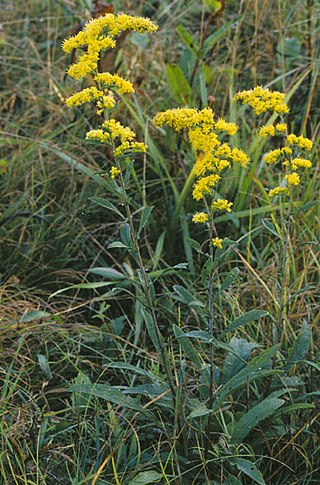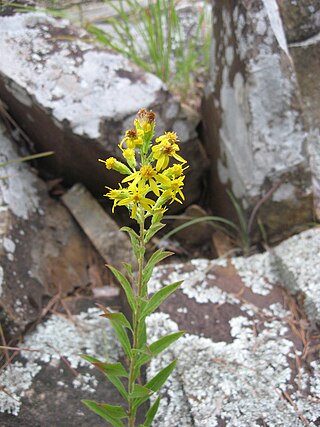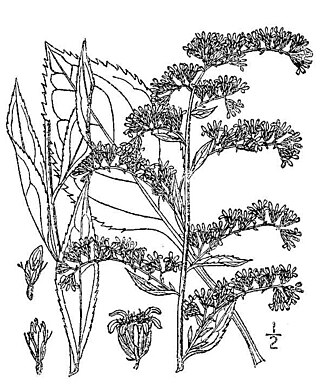
Solidago, commonly called goldenrods, is a genus of about 100 to 120 species of flowering plants in the family Asteraceae. Most are herbaceous perennial species found in open areas such as meadows, prairies, and savannas. They are mostly native to North America, including Mexico; a few species are native to South America and Eurasia. Some American species have also been introduced into Europe and other parts of the world.

Goldenrod is a common name for many species of flowering plants in the sunflower family, Asteraceae, commonly in reference to the genus Solidago.

Solidago caesia, commonly named blue-stemmed goldenrod, wreath goldenrod, or woodland goldenrod, is a flowering plant native to North America.

Solidago nemoralis is a species of flowering plant in the family Asteraceae. It is native to North America, where it is widely found in Canada and the United States. Its common names include gray goldenrod, gray-stem goldenrod, old-field goldenrod, field goldenrod, prairie goldenrod, dwarf goldenrod, and dyersweed goldenrod.

Solidago altissima, the tall goldenrod or late goldenrod, is a North American species of goldenrod in the family Asteraceae which is widespread across much of Canada, the United States, and northern Mexico. It is common in much of its range and fairly tolerant of landscapes which have been disturbed by humans. It has become naturalized in many parts of the world.

Solidago gigantea is a North American plant species in the family Asteraceae. Its common names include tall goldenrod and giant goldenrod, among others.

Solidago houghtonii is a rare North American species of flowering plant in the family Asteraceae known as Houghton's goldenrod. It is native to southern Ontario, Canada and the northern United States. It is threatened by the loss and degradation of its habitat. It is a federally listed threatened species of the United States and it is designated a species of special concern by Canada's Committee on the Status of Endangered Wildlife in Canada.

Solidago missouriensis is a species of flowering plant in the family Asteraceae known by the common names Missouri goldenrod and prairie goldenrod. It is native to North America, where it is widespread across much of Canada, the United States, and northern Mexico. It grows from British Columbia east to Manitoba, south as far as Sonora, Coahuila, Texas, and Mississippi.

Solidago villosicarpa is a species of flowering plant in the family Asteraceae known by the common names hairy-seed goldenrod, coastal goldenrod, glandular wand goldenrod, and shaggy-fruit goldenrod. It is endemic to North Carolina in the United States, where there are only four known populations.

Solidago velutina, the threenerve goldenrod or velvety goldenrod, is a plant species native to Mexico and to the western United States. The species has been found in southwestern Oregon, east to the Black Hills of South Dakota, and as far south as México State in the central part of the Republic of México. It is classified as a member of Subsection Nemorales.

Solidago ptarmicoides, the prairie goldenrod, white flat-top goldenrod or upland white aster, is a North American perennial flowering plant in the family Asteraceae. It is native to the central and eastern Canada and parts of the United States (mostly Great Lakes region, the Northeast, the Ozarks, and the northern Great Plains, with isolated populations in Wyoming, Colorado, Oklahoma, and scattered locations in the Southeast. It has also been called upland white solidago, upland white goldenrod, and sneezewort goldenrod

Solidago petiolaris is a North American species of goldenrod commonly called the downy ragged goldenrod. It is native to the United States and Mexico, in every coastal state from Texas to North Carolina, inland as far as southern Illinois, southern Nebraska, northeastern New Mexico, and Coahuila. Its preferred habitat is sandy areas.

Solidago arguta, commonly called Atlantic goldenrod, cut-leaf goldenrod, and sharp-leaved goldenrod, is a species of flowering plant native to eastern and central North America. It grows along the Gulf and Atlantic states of the United States from Texas to Maine, inland as far as Ontario, Illinois, and Kansas. It is primarily found in areas of woodland openings, such as outcrops or clearings.

Solidago lepida, the western Canada goldenrod or western goldenrod, is a North American plant species in the genus Solidago of the family Asteraceae. It is widespread across much of Canada, the western United States, and northern Mexico.

Solidago rigida, known by the common names stiff goldenrod and stiff-leaved goldenrod, is a North American plant species in the family Asteraceae. It has a widespread distribution in Canada and the United States, where it is found primarily east of the Rocky Mountains. It is typically found in open, dry areas associated with calcareous or sandy soil. Habitats include prairies, savannas, and glades.

Solidago mollis is a North American species of flowering plant in the family Asteraceae known by the common names velvety goldenrod, soft goldenrod or Ashly goldenrod. It is native to the central United States and central Canada, primarily the Great Plains from the Canadian Prairie Provinces south as far as Texas and New Mexico.

Solidago nana is a North American plant species in the family Asteraceae, with the common names baby goldenrod and dwarf goldenrod. The species is native to deserts and mountainsides in the western United States, from the Rocky Mountains to the Great Basin in the states of Idaho, Montana, Nevada, Utah, Wyoming, Colorado, Arizona, and New Mexico.
Solidago sciaphilia is known as shadowy goldenrod or cliff goldenrod. The species is endemic to bluffs along the Mississippi River in southern Minnesota, and the driftless area of southwestern Wisconsin, northern Iowa and Illinois. Throughout its range, S. sciaphila is strongly associated with dolomite and sandstone bedrock, especially dry cliffs. It can be similar to Solidago speciosa but has more serrate lower and mid stem leaves and is generally smaller to much smaller when growing in pockets of shallow soil on cliffs. Small plants are similar to Solidago hispida in general appearance. Blooming occurs late August through late September; fruiting occurs throughout September. Shadowy Goldenrod is considered a Special Concern species in Wisconsin and Minnesota, and considered threatened in Illinois. This species can be significantly impacted by rock climbing activities.

Solidago wrightii, commonly known as Wright's goldenrod, is a North American species of goldenrod in the family Asteraceae. It grows in northern Mexico and the southwestern United States.

Solidago capulinensis, known as the Capulin goldenrod is a rare plant endemic to Capulin Volcano National Monument and Las Animas County, Colorado and was first described and collected in 1936 by Theodore Dru Alison Cockerell and Darwin Maxson Andrews.



















